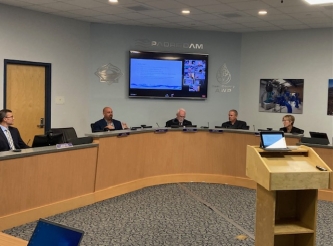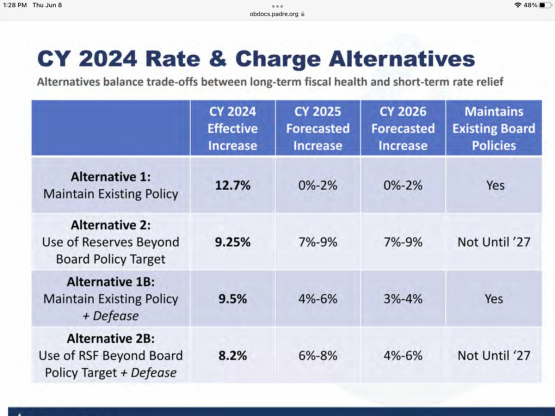Hike is expected to be passed on to customers, but amounts likely to vary by agency; increase slated to be somewhere between 16 percent and 22 percent in 2025
Original Article: Click Here
By David Garrick
SAN DIEGO —
County water officials say the amount they charge local agencies for wholesale water must increase 39 percent over the next three years, including a hike between 16 percent and 22 percent during 2025.
The enormous increases will force local agencies to also raise rates, but how much of the hikes they pass on to customers will vary widely among the roughly two dozen agencies that buy from the County Water Authority.
Some agencies have large local supplies, like Sweetwater with its groundwater basin, that allow them to buy less from the county authority. But others, like the city of San Diego, rely on the authority for as much as 90 percent of their water.
Water authority officials said the fundamental problem is that they borrowed money to build and maintain a significantly larger water storage and delivery system than is needed.
Officials expected demand to continually grow as population increased and development expanded, but member agencies have been buying steadily less wholesale water during the last two decades.
While that has allowed the water authority to buy less imported water from outside the region, it hasn’t shrunk the fixed costs the authority faces to pay off construction bonds and maintain the system.
Lower demand for water is primarily the result of widespread conservation, replacement of grass with zeroscape yards and a shrinking farm industry, officials said.
And the problem is only expected to get worse over the next few years when three large agencies — San Diego, Oceanside and El Cajon — start recycling sewage into drinking water they can use instead of wholesale water.
The authority also faces short-term problems, including two consecutive remarkably wet winters that have sharply reduced the need for outdoor irrigation.
Water sales to local agencies were 36 percent below projections during January, February and March of this year. That comes after sales were 27 percent below estimates during 2023.
Another short-term problem is the departure from the water authority of agencies serving Fallbrook and Rainbow, which opted to get water from nearby Riverside County instead.
The authority is receiving exit fees from Fallbrook, which detached Jan. 1, and Rainbow, which is slated to detach this fall. But officials said those fees don’t cover the authority’s costs related to Fallbrook and Rainbow.
“Those agencies are no longer paying their fair share,” Pierce Rossum, the authority’s rate and debt manager, told the authority board Thursday afternoon in Kearny Mesa.
In addition, the Metropolitan Water District of Southern California has approved rate hikes of 8.5 percent each for both 2025 and 2026 that will increase the county authority’s costs.
The Los Angeles-based agency sells wholesale supplies to San Diego and transports the region’s Colorado River water.
And the county authority is also facing higher charges to produce water desalinated in Carlsbad, and other storage and supply costs officials say are outside their control.
The costs outside the authority’s control, which officials call external costs, make up about two-thirds of the 39 percent in total hikes officials say are required during 2025, 2026 and 2027.
Of the 16 percent to 22 percent hikes required in 2025, external costs account for 11 percent.
Authority officials are asking the 36-member board to decide whether they want to tack on either 5 percent, 9 percent or 11 percent to that external 11 percent.
Board members said Thursday that whether the increase next year ends up being 16 percent or 20 percent or 22 percent, it’s upsetting.
“Less than a year ago we had a rate chart of alternatives with a forecast increase of no more than 6 or 8 percent,” said Neal Meyers, a board member representing the Olivenhain Municipal Water District. “To be here and hearing 20 percent, that’s very frustrating.”
The 22 percent increase in 2025 would allow the authority to keep its cash flow at recommended levels and continue to make infrastructure investments that will keep water facilities reliable, officials said.
Shrinking the increase to 16 percent in 2025 would lower cash flow, possibly jeopardizing the authority’s credit rating, and force postponement of some infrastructure projects.
Gary Hurst, a board member representing the Ramona Municipal Water District, said he was not enthusiastic about delaying projects.
“What you’re really doing is creating a backlog of repair and replacement projects,” Hurst said. “You’re creating a giant hurdle for future financing.”
If the board opts for 16 percent in 2025, the increases in 2026 and 2027 would have to be sharper to get to the 39 percent total.
Joy Lyndes, a board member representing the San Dieguito Water District, said the sharp increases make sense if they are viewed as the first step of a long-term stabilization plan.
“There’s a lot that’s happened to us in the last few years that we’re responding to now,” Lyndes said. “We have to really make some corrections and it may take us five to 10 years.”
Authority officials said they expect the board to decide on the 2025 rate increase in May and finalize it in June.


